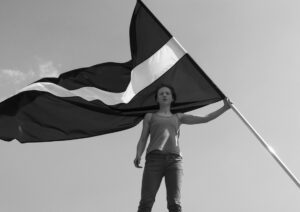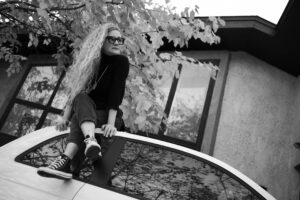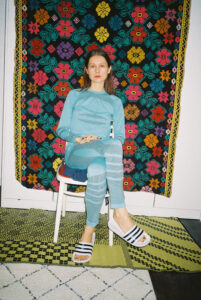Lala Meredith-Vula
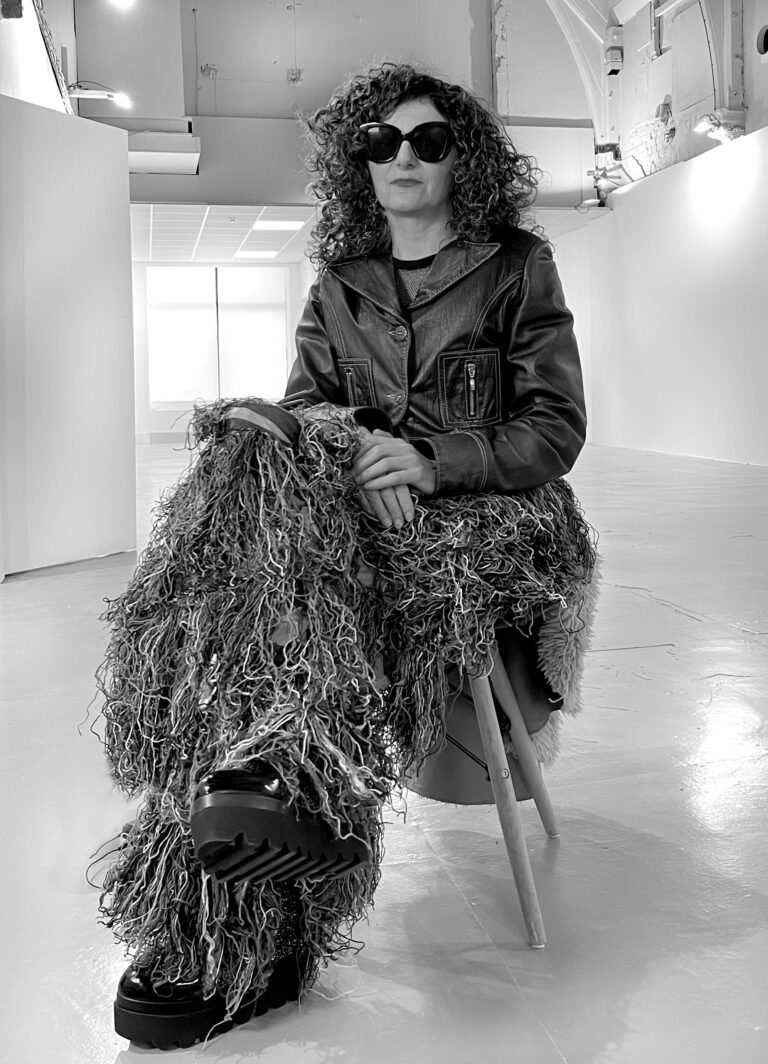
— born in Sarajevo in 1966 to an Albanian father and English mother. She moved to England at an early age and did not return to the Balkans until after graduating from Goldsmiths University in 1988. Her work was first shown that year in Damien Hirst’s landmark exhibition “Freeze” in London and she went on to exhibit regularly in the UK, USA, China, and throughout Europe. She represented Albania in the 48th Venice Biennale of 1999 and in 2017 took part in documenta 14 in Athens and Kassel. One of her most recent group exhibitions was the needle, the haystack, the thread, curated by Monika Szewczyk at The Arts Club of Chicago. She recently exhibited in Phair, May 2022 with the Peola Contemporary Art Gallery in Torino, Italy. She is an artist and Professor of Art and Photography at De Montfort University, Leicester, UK.
When I was a child I was uprooted from one culture to another. Not knowing the local language at this early age I discovered that the language of art was universal. I discovered at age of four I could draw and people could understand me. And people noticed my talent. I was obsessed with horses as a child, first seeing them pulling carts in Sarajevo then pretending to be a horse and riding horses growing up. At six years old I painted a horse, the painting was titled Horse1 which was sold at an art fair to raise money for the school. That painting is still owned and valued by the buyer who has framed the picture and hangs it in their family home.
As I was always good at art in school it was a natural progression to then study art. I first studied an art foundation course that gave me the chance to explore all art disciplines, such as design, fashion, and sculpture before selecting painting. I would sketch my ideas as paintings quickly like Claude Monet and the impressionist painters. However, after several visits to Kosovo, I found photographing a quicker method for capturing ideas, and I would return to the studio and then paint from the photographs I had taken and ‘make art’ from them. During my student days, a tutor Ian Jeffrey, the renowned art writer, and critic, head of Art History at Goldsmiths College2, suggested I should exhibit the photographs on their own. This was a pivotal moment for me as I realized the photographs were strong enough on their own without having to paint from them.
After graduating in London in 1988 I went to live in Kosovo to connect with the land of my father and his family where I also began to learn the Albanian language. It is here I began the haystack project3 which linked in with my early obsession with horses as it was based on horse feed. I found art in the landscape as I felt the haystacks were like land sculptures. It felt like my homeland and my artistic background were united in these land sculptures that were made by the farmer and sometimes the animals that fed from them.
I was obsessed with haystacks at the time and a friend Violeta Bardhi from the Drenica region invited me to go to witness one of the first large Reconciliation of Blood Feuds Campaign gatherings. I was so moved at that moment, it felt like I was taking part in a monumental and historic event. From that day, I followed all the other mass reconciliations and then became involved with the grassroots team. We visited the feuding families to encourage them to ‘forgive the blood’ and end the feud.
These few years were very turbulent political times in Kosovo and in 1990 I had the opportunity to follow and work with the Blood Feud Reconciliation Movement4 and its figurehead Anton Çetta. This historical moment shaped my life as it was an extraordinary and emotionally moving campaign and inspired me throughout my life. In 1991 after many visits to London, I made a documentary film with the BBC called, Forgiving the Blood. This was shown recently in 2019 in Dokufest and some of the participants were in the audience.
Today, I work mainly with photography, drawing, performance, and film. I have taught art to students for over 30 years and, now as a professor, this is an important part of my artistic practice. I am fascinated by the art school environment and the reciprocal tutor-student relationship.
My cultural identity is a curious one. My parents divorced when I was four years old in Sarajevo and I went to live in England with my English mother. My father went to Kosovo and lived there all his life. He married again and I have four sisters who also helped me to connect more to Kosova. We speak to one another in the Albanian language. So I had each parent at home in their own homeland rather than having parents that were new to a culture respectively. My mother later emigrated to Zimbabwe and married there. This not only gives me a strong identity but somehow an equal belonging and outsider feeling to both cultures. I have drawn from this as inspiration in many of my works.
Shifting Borders is a series of work that I made in 2006 – 2008, where I originally placed myself in Albanian costumes in locations around Kosovo, Albania, England and Zimbabwe, and then I used models in various Albania costumes from different regions. Sometimes I even photographed myself placing the costumed people as ways of examining identity visually. I decided to compose the works with a small figure reacting to real situations in the landscape. I chose to do this in black and white to use the pictorial language of historic photography.
The two works to the right of the picture are from my Shifting Borders5 series showing a figure in Albanian costume one is in Kosovo6 the other taken in Zimbabwe7. Although the curator of this exhibition put this together at random the two pictures seem to represent my mother and my father. The Zimbabwe mother has round, earth-like images whereas my father’s Kosovo picture is square and angled (my father was an architect in Kosovo) somehow subconsciously I have pointed to this and it was this exhibition that highlighted this. This ongoing process of exhibiting and re-evaluating my work is also my process.
My work is highly instinctive and I do not think things through in my process. I react to things emotionally by drawing and taking pictures without thinking. Just like I captured the farmers’8 as they walked over the hill and instinctively took this picture. Usually, people hide their contradictions, while I like to show mine in my work. This approach is visible in the work I have produced over the past three decades. I want to unify all the elements of myself in my artwork. It is like a jigsaw puzzle for the viewers to unravel.
In my work, I have been representing women either washing in Hamam Turkish Baths or bodies de-formed by water9. I have many different bodies of work and I sometimes work on them in tandem. Often adding work to various existing series. The series, Personality Explored10 started back in 1986. It is a theme I keep returning to using the nude female form as a starting point. It is what connects my work, the bodies of women in the Hamam to the women in Has Kosova11 to the Women in Water. I guess I am the thing that connects them. They moved me and I wanted to capture them and make art about them. Much of my work is ongoing and there are series and themes that run as far back as 1986 during my time as a student to the present day.
In my everyday life I am a mother, artist and professor at a university. As many people, I juggle trying to keep all the things going. Being an artist is difficult as usually the time gets spent on more demanding aspects of my life and so I have to be disciplined and committed to going into my studio and creating art. I identify as non-binary as I have many male and female aspects. I brought up my child on my own and took on the role of the father and mother. Lala is actually a male name in Albanian; it means ‘best man.’ The best man who collects the bride at a wedding, “O po vjen goca moj Lala, (Oh the lass is coming Lala)” as the Kosovo folk song goes…
1Image: Lala Meredith-Vula, Horse, Painting, 1972.2Image: Lala Meredith-Vula, In the photograph, Goldsmith’s College Studios 1987 my tutor the renowned sculptor Carl Plackman gave one of my fellow students a tutorial at Goldsmiths College London University art studios in 1987. Courtesy of the artist.
3Image: Lala Meredith-Vula, Haystack Project, Photography. Courtesy of the artist.
4Image: Lala Meredith-Vula, Blood Memory, Photography, 1 May, 1990, Verrat e Llukës. Courtesy of the artist.
5Image: Lala Meredith-Vula, Shifting Borders, 2016, Photography London Art Fair of Modern British & Contemporary Art. Courtesy of the artist.
6Image: Lala Meredith-Vula, Shifting Borders Kosovo, Photography. Courtesy of the artist.
7Image: Lala Meredith-Vula, Shifting Borders Zimbabwe, Photography. Courtesy of the artist.
8Image: Lala Meredith-Vula, Photograph, Rugova, Kosova, 1990. Courtesy of the artist.
9Image: Lala Meredith-Vula, Women and Water, Photography. Courtesy of the artist.
10Image: Lala Meredith-Vula, Personality Explored no. 2, Photography. Courtesy of the artist.
11Image: Lala Meredith-Vula, Women of Has in Gjonaj at a huge Blood feud reconciliation gathering on May 2, 1990, Photography. Courtesy of the artist.
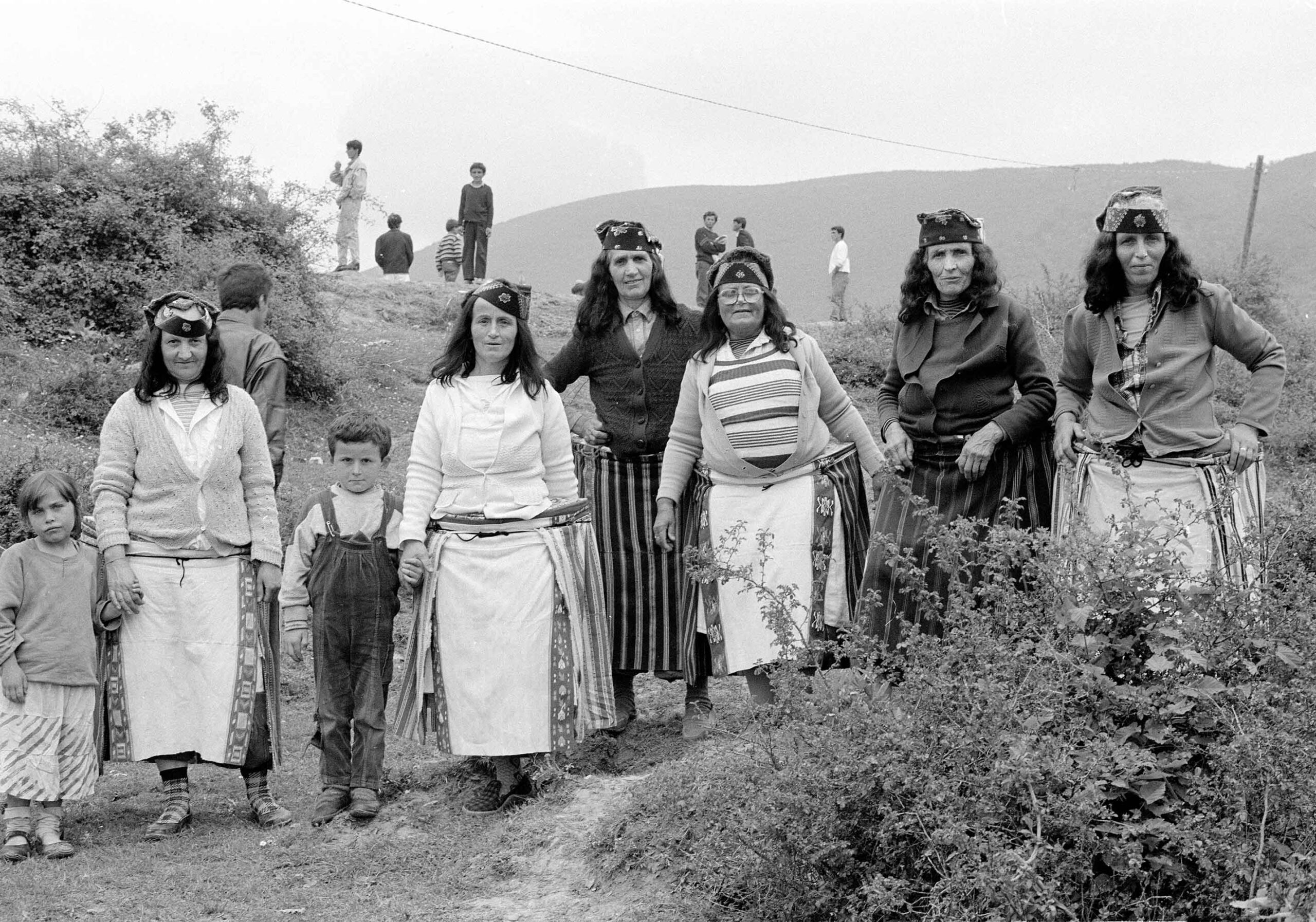
— e lindur në Sarajevë në vitin 1996 nga baba shqiptar dhe nënë angleze. Ajo u vendos në Angli në një moshë të re dhe nuk u kthye në Ballkan deri pas diplomimit nga Goldsmiths University në vitin 1988. Puna e saj për herë të parë u shfaq atë vit në ekspozitën histori-bërëse të Damien Hirst “Freeze” në Londër dhe pastaj vazhdoi me ekspozita të rregullta në MB, SHBA, Kinë, dhe gjithandej Evropës. Ajo përfaqësoi Shqipërinë në Bienalën e 48-të të Venedikut në vitin 1999 dhe më 2017 morri pjesë në documenta 14 në Athinë dhe Kassel. Një prej ekspozitave grupore më të fundit ishte gjilpëra, kashta, fija (needle, the haystack, the thread), e kuruar nga Monika Szewczyk në The Arts Club të Çikago. Së fundmi, ajo ka ekspozuar në Phair, Maj 2022 me Galerinë e Artit Bashkëkohor Peola në Turin, Italy. Ajo është një artiste dhe Profesoreshë e Artit dhe Fotografisë në De Montfort University, Leicester, MB.
Kur isha fëmijë, zhvendosesha nga një kulturë në tjetrën. Duke mos ditur gjuhën në këtë moshë të re, zbulova që gjuha e artit ishte universale. Në moshën katër vjeçe, zbulova që mund të vizatoja dhe që njerëzit mund të më kuptonin. Dhe njerëzit vërejtën talentin tim. Isha e obsesionuar me kuajë si fëmijë, së pari i pash duke tërheq karroce në Sarajevë, pastaj duke u shtirur që isha kalë dhe kalërimi i kuajve kur po rritesha. Në moshën 6 vjeçare, pikturova një kalë, me titullin Kali(Horse)1, e cila u shit nënjë panair arti për të ngritur fonde për shkollën. Ajo pikturë ende është në pronësi dhe vlerësohet nga blerësi, i cili e ka vënëpikturën në kornizë në mur në shtëpinë familjare.
Meqë gjithë isha e mirë në art në shkollë, ishte e natyrshme për mua të vazhdoj pastaj të studioj artin. Së pari studiova themelet e artit në një kurs, që më dha mundësinë të eksploroj të gjitha disiplinat e artit, si dizajni, moda, dhe skulptura, para se të zgjidhja pikturën. Idetë e mia i skicoja si piktura aq shpejt sa Claude Monet dhe piktorët impresionist. Megjithatë, pas disa vizitave nëKosovë, zbulova që fotografimi është metodë më e shpejtë për nxënien e ideve, dhe pastaj kthehesha në studio dhe i pikturoja nga fotografitë që kisha bërë dhe ‘bëja art’ nga ato. Mësuesi Ian Jeffrey, shkrimtari i njohur mbi artin, dhe kritiku i cili ishte udhëheqës i Historisë së Artit në Goldsmiths College2, kur isha studente më sygjeroi që të ekspozoj fotografitë më vete. Ky ishte moment vendimtar për mua pasiqë kuptova që fotografitë ishin mjaftueshëm të fuqishme pa pasur nevojë t’i pikturoj.
Pas diplomimit në Londër më 1988, u ktheva të jetoj në Kosovë për t’u lidhur me tokën e babait tim dhe të mësoj gjuhën shqipe, dhe fillova projektin e kashtës (haystack)3 i cili lidhej me obsesionin tim të hershëm me kuajë, meqë kjo ishte ushqim për kuajë. Zbulova artin në peisazh, derisa po ndjeja kashtën, ishte si skulpturë toke. U ndjeva sikur mëmëdheu im dhe sfondi im historik ishin bashkuar në këto skulptura të tokës, që ishin bërë nga fermeri, dhe ndonjëherë nga kafshët që ushqeheshin nga ato.
Isha e obsesionuar me mullaret e barit atëkohë, dhe një shoqe, Violetta Bardhi nga rajoni i Drenicës, më ftoi të shkoj të shoh njëprej mbledhimeve më të mëdha të para të pajtimit. U preka aq shumë në atë moment, u ndjeva sikur po merrja pjesë në një ngjarje të madhe monumentale historike të kohës sonë. Nga ajo ditë, unë ndoqa të gjitha mbledhimet e tjera në masë, dhe pastaj u përfshiva me ekipin organizues. Vizituam familjet në gjak për t’i inkurajuar që të falin gjaqet.
Këto vite ishin kohëra shumë të turbullta politike në Kosovë, dhe në vitin 1990, pata mundësinë të ndjek dhe punoj me Lëvizjën për Pajtimin e Gjaqeve4 dhe figurën e saj kryesore Anton Çetta. Kjo ngjarje historike ndikoi në formësimin e jetës simë, pasiqëishte një ngjarje tejet prekëse dhe e cila më inspiroi përgjatë gjithë jetës sime.
Më 1991, pas shumë vizitave në Londër, unë bëra një film dokumentar me BBC, të quajtur Falja e Gjakut. Ai u shfaq së fundmi më 2019 në Dokufest, dhe disa prej pjesëmarrësve në film ishin prezent në audiencë.
Sot, kryesisht punoj me fotografi, vizatim, performancë, dhe film. Kam ligjëruar art për mbi 30 vite, dhe tani si profesoreshë, ajo është një pjesë e rëndësishme e punës sime. Jam e fascinuar nga ambienti i shkollës së artit dhe marrëdhënieve reciproke mësues-student.
Identiteti im kulturor është i çuditshëm. Prindërit e mi u shkurorëzuan kur isha katër vjeçe në Sarajevë, dhe unë shkova të jetoj në Angli me nënën time angleze. Babai im u kthye në Kosovë dhe jetoi atje gjithë jetën e tij. Ai u martua prapë dhe unë kam katër motra të cilat gjithashtu më ndihmojnë të lidhem më shumë me Kosovën. Kur jemi së bashku flasim shqip. Pra, kisha secilin prind që ishte në mëmëdheun e tij/saj, në vend se prindër që ishin të ri për një kulturë. Nëna ime më vonë emigroi në Zimbabve dhe u martua atje. Kjo jo vetëm që më jep një identitet të fortë, por disi një përkatësi të barabart dhe ndjesi nga jashtë për të dy kulturat. Kjo më ka frymëzuar si inspirim në shumë prej veprave të mia.
Shifting Border (Kufiri Lëvizës), është një seri e veprave që i bëra më 2006-2008, ku fillimisht vendosa vetën në kostume shqiptare në lokacione rreth Kosovës, Anglisë dhe Zimbabvesë, dhe pastaj përdora modelet në kostume të ndryshme të Shqipërisënga rajone të ndryshme. Ndonjëherë edhe fotografoja veten duke vendosur njerëzit e veshur me kostumet si mënyra tëekzaminimit të identitetit në mënyrë vizuale. Vendosa që të kompozoj veprat me figurën të vogël në peisazh dhe duke reaguar me situatat reale në peisazh. Zgjodha të bëjë këtë në bardh e zi për të shfrytëzuar gjuhën piktoreske të fotografisë historike.
Dy veprat në të djathtë të fotografisë janë nga cikli e “Kufijtë Lëvizës (Shifting Borders)5, cikli që tregon një figurë me kostum shqiptar një është në Kosovë6 dhe tjetra e bërë në Zimbabve7. Edhe pse kuratori i kësaj ekspozite i ka vendosur këto së bashku në mënyrë rastësore, dy fotografitë duket se përfaqësojnë nënën dhe babain tim. Ajo e nënës Zimbabveane ka imazhe të rrumbullakëta që ngjajnë me tokën, përderisa fotografia e babait tim nga Kosova është katrore dhe këndore (babai im ishte arkitekt në Kosovë). Disi në mënyrë të nën-ndërgjegjshme i kam vënëvëmendjen kësaj dhe ishte kjo ekspozitë që vuri në dritë këtë aspekt. Ky proces i vazhdueshëm i ekspozimit dhe rivlerësimit tëpunës sime është edhe procesi im.
Puna ime është shumë instinktive dhe nuk i procesoj gjërat në procesin tim. Reagoj emocionalisht ndaj gjërave, duke vizatuar apo duke bërë fotografi pa menduar. Ashtu sikur bëra fotografinë e fermerëve’8 kur po kalonin nëpër kodër dhe unë instinktivisht bëra këtë fotografi. Zakonisht, njerëzit fshehin kundërthëniet e tyre, përderisa unë dua t’i tregoj të miat në punën time, dhe kjo është e dukshme në punën që kam prodhuar gjatë tri dekadave të fundit. Unë dua të bashkoj të gjitha elementet e vetes sime nëpunën time artistike. Kjo është sikur një enigmë të cilën shikuesit duhet t’a zgjidhin.
Kam përcjellur gratë ose duke u larë në Hamamet Turke ose trupat e çformuar nga uji9. Kam shumë seri të punëve dhe ndonjëherë punoj në to si bashkësi. Shpesh i shtoj punë serive të ndryshme. Seritë, Eksplorimi i Personalitetit (Personality Explored)10 filluan qysh në vitin 1986. Është një temë të cilës i kthehem kohë pas kohe, duke përdorur lakuriqësinë apo trupin e gruas si pikë fillestare. Ajo që lidh punën time, trupat e grave në Hamam me gratë në Hasin e Kosovës11 me Gratë në Ujë. Me gjasë jam unë ajo që i lidh. Ato më prekën dhe dëshirova ti fotografoj dhe të bëjë art rreth tyre. Shumë prej punës sime është nëproces e sipër, dhe ka seri dhe tema të cilat i takojnë së kaluarës qysh në vitin 1986, si studente e shkollës e deri në ditën e sotme.
Në jetën time të përditshme unë jam një nënë, artiste dhe profesoreshë në Universitet. Si shumë njerëz, manovroj që t’i mbaj tëgjitha gjërat në jetë gjallë. Të qenurit artiste është e vështirë, pasiqë zakonisht koha shpenzohet në aspekte më kërkuese të jetës, dhe kështu më duhet të jem e disiplinuar dhe e përkushtuar të shkoj në studion time dhe të krijoj art. Unë identifikohem si jo-binare pasiqë kam shumë aspekte mashkullore dhe femërore. Fëmijën time e rrita vet dhe u bëra roli i babait dhe i nënës. Lala nëfakt është emër mashkulli në shqip; ajo domethënë ‘best man’ (Lala). Lala i cili e merr nusen në një dasmë,”O po vjen goca moj Lala”, siç shkon një këngë folklorike kosovare…
1Imazh: Lala Meredith-Vula, Horse, Pikturë, 1972.2Imazh: Lala Meredith-Vula, Goldsmith’s College Studios 1987 mësuesi im, skulptori i njohur Carl Plackman i dha njërës prej kolegeve të mia studente një tutorial në studiot artistike të Universitetit Kolegj Goldsmiths në Londër, 1987.
3Imazh: Lala Meredith-Vula, Fotografi, Haystack Project.
4Imazh: Lala Meredith-Vula, Fotografi, Blood Memory, Verrat e Llukës, 1 May, 1990.
5Imazh: Lala Meredith-Vula, Shifting Borders, 2016, Fotografi, London Art Fair of Modern British & Contemporary Art.
6Imazh: Lala Meredith-Vula, Shifting Borders Kosovo, Fotografi.
7Imazh: Lala Meredith-Vula, Shifting Borders Zimbabwe, Fotografi.
8Imazh: Lala Meredith-Vula, Rugovë, Kosovë, 1990, Fotografi.
9Imazh: Lala Meredith-Vula, Women and Water, Fotografi.
10Imazh: Lala Meredith-Vula, Personality Explored nr. 2, Fotografi.
11Imazh: Lala Meredith-Vula, Gratë e Hasit në Gjonaj në një tubim të madh të pajtimit të gjaqeve më 2 maj 1990, Fotografi.
